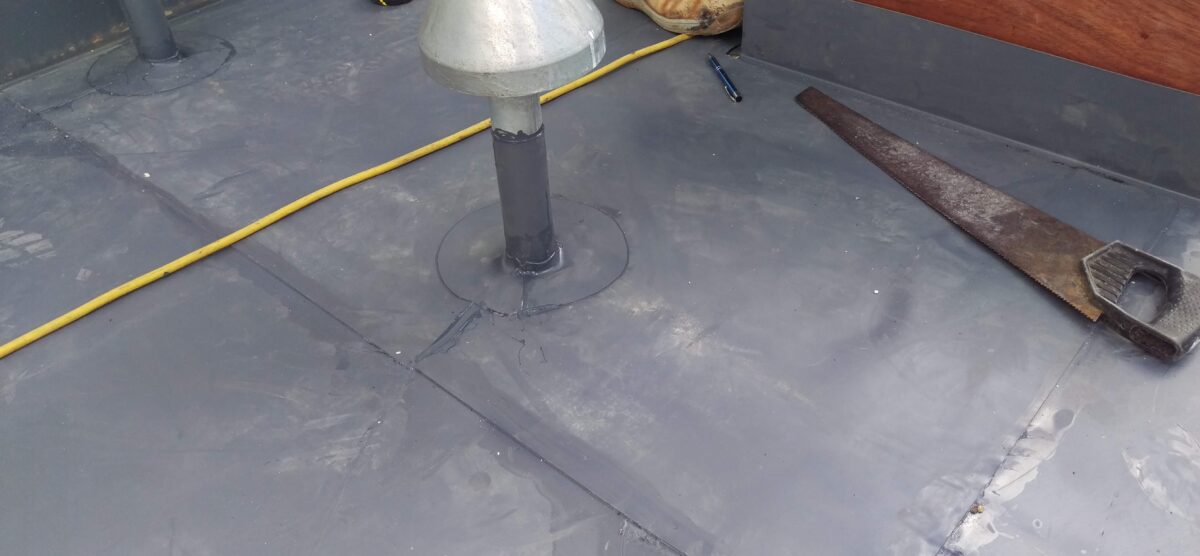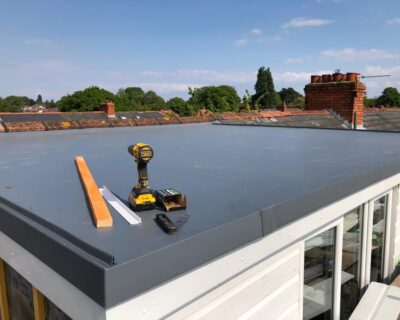Blog & News

How Can I Make My Flat Roof Last Longer?
Out of sight out of mind, as the saying goes. We all tend to apply this mentality to our roofs, ignoring them until there’s an issue.
Unfortunately, roof problems aren’t always a simple fix and they tend to get worse the longer they are ignored.
Flat roofs, while being cheaper to build, can lead to serious problems if not maintained properly. The major issue is that flat roofs don’t drain as well as pitched roofs. This can lead to problems such as ponding, leaks, vegetation growth, and blistering.
It’s important to keep your flat roof in top condition to mitigate any of these problems. Luckily, flat roof maintenance is fairly simple and requires simple household tools.
Basic Maintenance
At the most basic level, you’ll need to visually inspect your roof and keep it clean.
Visual Inspections
You’ll need to inspect your roof twice a year. These visual checks should be conducted on the inside and outside of your roof.
For external inspections, you’ll want to get as close to the roof as possible. This might mean scaling a ladder or climbing out onto the flat roof. Always make sure that someone is around to provide help if you encounter any problems.
It’s important to note that not all flat roofs are designed to be walked on. If your roof was not built to be a terrace or balcony you should avoid walking on it and stick to the ladder.
When you conduct your visual inspection you should look for the following things:
- Ponding – this is where water gathers on an insufficiently sloped part of the roof. It can cause stress and damage if left unchecked.
- Mould and mildew – lookout for any foliage making its home on your roof. Mould and mildew can spread to the interior of your home and can damage the roof materials.
- Punctures, tears, and blisters – these will be fairly obvious signs of damage to the roof materials. You’ll want to address these as soon as possible as this is where water will enter your home.
- Poor seals – these will be noticeable at the edges of the roof and where the outer coating joins. Over time the caulking or tar that holds the roof materials together can degrade. If you notice gaps or deterioration you’ll need to get them repaired to protect the waterproofing of your roof.
- Loose seams – Sometimes the seals around your roof can come free. This will allow water and dampness to seep into your home. You’ll need to reseal these as soon as possible.
- Debris – Leaves, dirt and stray footballs will invariably end up on your roof at some point. Though not damaging individually, they can cause stress when they build up. General debris will need to be removed.
- Gutters and drains – while you’re up there you might as well check the gutters. You’re looking for debris that clogs up the gutters and prevents water from draining. This causes water to sit on your roof which is not a good idea.
For internal inspections, you are mostly looking for signs and symptoms of roof issues. Check for any patches of damp on the walls and ceilings. Sometimes these only show up following rain so make sure to check after a downpour.
You’ll also want to keep an eye out for seeping water. This is the precursor to a leak and can be harder to spot. Essentially, your walls should not be wet. If they are, you have a problem.
Cleaning Your Roof
As mentioned above, you are going to need a ladder or access to your roof. Only ever stand on a flat roof if it was designed to take a person’s weight. If you’re not sure, don’t push it.
Your cleaning schedule should consist of clearing debris, washing away mould and mildew and cleaning the gutters.
You can do this yourself or you can call in a professional. There are lots of roofing companies that offer inspection and cleaning services as well as specialised cleaners.
If you do want to do it yourself, you’re going to need a stiff-bristled broom, a ladder, pair of rubber gloves and a hand brush for the gutters.
Set up your ladder, ensuring that someone is there to stabilise the bottom of the ladder. Do not do this alone.
Use the sweeping brush to drag debris and dirt towards you and off the roof. Only go as far as you can comfortably reach without overstretching. You don’t want to fall from the ladder after all!
Once you’ve removed the debris, look for patches of moss or mould. Use the broom to try and dislodge them. This is why you need a stiff-bristled broom, it is much better at shifting stubborn mould. Once dislodged, you’ll need to brush them off the roof.
Again with the broom, sweep away any patches of ponding water. If you have a long-handled squidge handy you can use that. If not, the broom will do.
The final step is to clear the gutter of debris. You’ll want to use a smaller brush to sweep along the gutters. You might need to get your hand in there at some point so we recommend you wear gloves.
You will have to come down the ladder, reposition and go back up. This will probably happen a few times. Yes, it’s a hassle, but it’s better than overreaching and falling off the ladder.
When you are clearing the debris and water, try to remember someone is holding the ladder below you. They won’t appreciate a shower of mucky pond water!
If you happen to have a pressure washer, you can use that to clear away smaller bits of dirt and debris. Pressure washers are also great at shifting stubborn mould and mildew.
Just remember to be careful where you point the wand. Your neighbour won’t appreciate a garden full of your roof debris.
Noticing Damage
If during your inspection or cleaning you notice damage, you’ll need to get it checked out by a professional. You may be able to patch the problem until a contractor can come out but long term roof repairs should be carried out by a qualified roofer.
Final Thoughts
Maintaining your flat roof is fairly simple. It’s mostly a case of cleaning it when it’s dirty and inspecting it every 6 months.
Sure, the process of cleaning your roof is a bit arduous, but you can always call in a pro.
Ultimately, as annoying as cleaning and inspecting your roof can be, it is cheaper and easier than having to fix a leak at a later stage.



